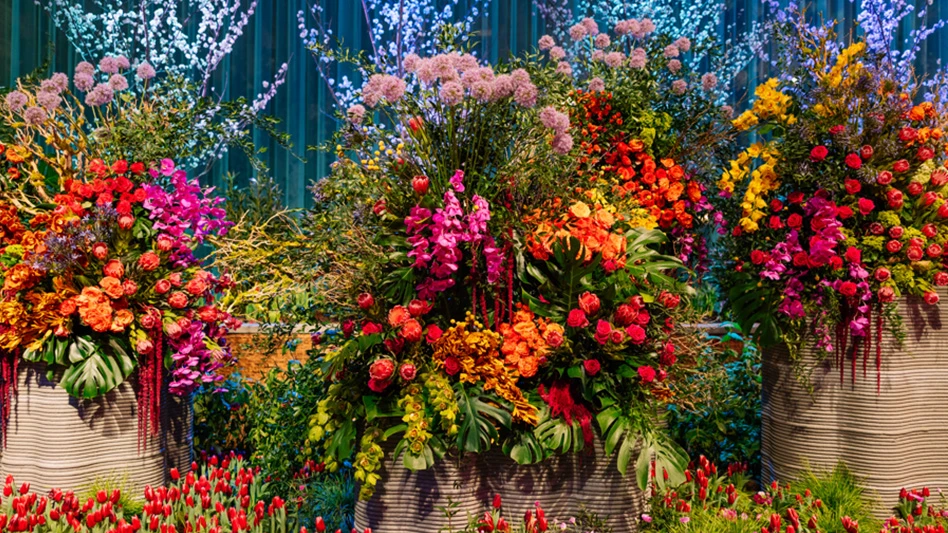
Specializing in hydroponic leafy greens and hemp production to help communities, regions and brands sustainably grow large amounts of produce, Eden Green Technology in Cleburne, Texas, provides customizable technology aimed at advancing its motto, "Locally grown, globally available."
Greenhouse Management: What crops do you grow, and what type of greenhouses do you utilize for that purpose?
Eden Green Technology: We mostly grow leafy greens and herbs such as spinach, romaine and basil, or Asian greens like pak choi or joi choi. There are also peppers, tomatoes and snap peas. We also have a hemp license and are doing some trials right now. We have a gutter connect greenhouse with 11 30-foot bays, as well as a double poly insulated roof layer and a polycarbonate dual wall around the outside.
GM: What type of supplemental lighting are you employing now, and on which crops?
EGT: We’re using all LED fixtures. We’re using supplemental lighting on a fifth of our production area along with about four trial sectors. For leafy greens, we focus on spinach and lettuce. We also have crops such as kale and arugula that can get by without light, but spinach, lettuce and basil are pretty light-hungry as far as greens go. Our hemp crop has light on it, too, but that’s a smaller trial section.
GM: Can you describe your set up?
EGT: Right now in production, we’re using a fixture with a red/blue color spectrum. It’s fully supplemental lighting, meaning those lights follow a program that allows us to use as much sun as possible. They’re 600-watt fixtures at 480 volts, which makes them more efficient. We have over 120 of those lights in production areas and another two dozen in trials in other sections of the greenhouse. I also use red/blue fixtures and have a vertical shelf propagation area that uses LEDs.

GM: Why do you use supplemental lighting, and in what ways is this technology important to the success of your crops?
EGT: Being in Texas, we get enough natural light to grow leafy greens, but we wanted to improve overall yield for cloudy days. Also, different rows of crops get direct sunlight during some hours and not during other hours. Supplemental lighting helps us improve consistency and control crop morphology. We’re getting more consistent yield and deeper colors throughout the whole crop.
We went with LEDs from the get-go. I’ve been studying lighting for most of my career and set up lighting for a medical cannabis grow (with another company). When I got to Eden Green, I was in a position to put in lights for greenhouses that had never been lit. I was driven by success stories, which had technical support and data to back up their claims. Those got me in the door, and helped convince my board that we should put in supplemental LEDs. We used some for a whole row of produce and just loved it.
GM: Are you planning to add more supplemental lighting to any portion of your production area?
EGT: There are two builds we’re working on now that will support supplemental LED lighting. The challenge is convincing a board or company to spend millions of dollars based on good science and data, but not a lot of history.
When we got bad yields the first winter I was here, it was evident we needed supplemental lighting. I had data to support my claims, and the more experts I got in front of my owners, the easier it was to convince them. The yield in winter was at least 16 times more with some crops, when we were growing in the dark before.
The best bang for our buck was running at high voltage, although most greenhouses don’t have the amperage to do that overnight. It was much more expensive to increase our amperage than to buy the equipment.
For any greenhouse owner looking to buy supplemental lighting, I’d tell them to do their homework, and not let someone come in and acronym them to death. And have really good knowledge of what your plants need. Make sure the lighting company explains a technical light plan. Hands down, no exceptions.

Explore the July 2021 Issue
Check out more from this issue and find your next story to read.
Latest from Greenhouse Management
- KETOS launches in-house environmental lab testing for water quality
- Kaylee Marr to lead digital sales at Priva North America
- Disaster!
- Should we start calling natives 'eco-beneficial plants'?
- FNGLA celebrates passage of 2025 'Florida Farm Bill'
- Jim Owen joins Profile Products as technical services manager
- The Growth Industry Episode 4: How federal budget cuts are affecting horticulture nonprofits
- The HC Companies, Classic Home & Garden merge as Growscape






